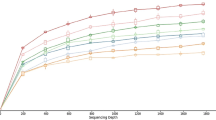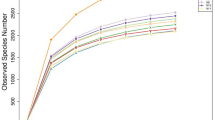Abstract
The genetic diversity of protozoa in Surti buffalo rumen was studied by amplified ribosomal DNA restriction analysis, 18S rDNA sequence homology and phylogenetic and Real-time PCR analysis methods. Three animals were fed diet comprised green fodder Napier bajra 21 (Pennisetum purpureum), mature pasture grass (Dicanthium annulatum) and concentrate mixture (20% crude protein, 65% total digestible nutrients). A protozoa-specific primer (P-SSU-342f) and a eukarya-specific primer (Medlin B) were used to amplify a 1,360 bp fragment of DNA encoding protozoal small subunit (SSU) ribosomal RNA from rumen fluid. A total of 91 clones were examined and identified 14 different 18S RNA sequences based on PCR–RFLP pattern. These 14 phylotypes were distributed into four genera-based 18S rDNA database sequences and identified as Dasytricha (57 clones), Isotricha (14 clones), Ostracodinium (11 clones) and Polyplastron (9 clones). Phylogenetic analyses were also used to infer the makeup of protozoa communities in the rumen of Surti buffalo. Out of 14 sequences, 8 sequences (69 clones) clustered with the Dasytricha ruminantium-like clone and 4 sequences (13 clones) were also phylogenetically placed with the Isotricha prostoma-like clone. Moreover, 2 phylotypes (9 clones) were related to Polyplastron multivesiculatum-like clone. In addition, the number of 18S rDNA gene copies of Dasytricha ruminantium (0.05% to ciliate protozoa) was higher than Entodinium sp. (2.0 × 105 vs. 1.3 × 104) in per ml ruminal fluid.

Similar content being viewed by others
References
Altschul SF, Madden TL, Schaffer AA, Zhang J, Zhang Z, Miller W, Lipman D (1997) Gapped BLAST and PSI-BLAST: a new generation of protein database search programs. Nucleic Acids Res 25:3389–3402
Benson DA, Karsch-Mizrachi I, Lipman D, Ostelland J et al (2007) GenBank. Nucleic Acids Res 35:D1–D25
Brookman JL, Mennim G, Trinci APJ, Theodorou MK, Tuckwell DS (2000) Identification and characterization of anaerobic gut fungi using molecular methodologies based on ribosomal ITS1 and 18S rRNA. Microbiol 146:393–403
Corliss JO (2002) Biodiversity and biocomplexity of the protists and an overview of their roles in the maintenance of our biosphere. Acta Protozool 41:199–219
Dehority BA (2003) Rumen microbiology. Nottingham University Press, Nottingham, UK
Dehority BA (1993) Laboratory manual for classification and morphology of rumen ciliate protozoa. CRC Press, Boca Raton, Florida
Dehority BA (1984) Evaluation of subsampling and fixation procedures used for counting rumen protozoa. Appl Environ Microbiol 48:182–185
Deng WD, Xi DM, Mao HM, Wanapat M (2008) The use of molecular techniques based on ribosomal RNA and DNA for rumen microbial ecosystem studies: a review. Mol Biol Rep 35(2):265–274
Felsenstein J (1985) Confidence limits on phylogenies: an approach using the bootstrap. Evolution 39:783–791
Finlay BJ, Esteban GF (1998) Freshwater protozoa: biodiversity and ecological function. Biodivers Conserv 7:1163–1186
Finlay BJ, Esteban G, Clarke KJ, Williams AG, Embley TM, Hirt RP (1994) Some rumen ciliates have endosymbiotic methanogens. FEMS Microbiol Lett 117:157–162
Franzolin R, Dehority BA (1996) Effect of prolonged high-concentrate feeding on ruminal protozoa concentrations. J Anim Sci 74:2803–2809
Hristov AN, Ivan M, Rode LM, McAllister TA (2001) Fermentation characteristics and ruminal ciliate protozoal populations in cattle fed medium- or high-concentrate barley-based diets. J Anim Sci 79:515–524
Ivan M, Neill L, Forster R, Alimon R, Rode LM, Entz T (2000) Effects of Isotricha, Dasytricha, Entodinium, and total fauna on ruminal fermentation and duodenal flow in wethers fed different diets. J Dairy Sci 83:776–787
Karnati SK, Yu Z, Sylvester JT, Dehority BA, Morrison M, Firkins JL (2003) Technical note: specific PCR amplification of protozoal 18S rDNA sequences from DNA extracted from ruminal samples of cows. J Anim Sci 81:812–815
Khampa S, Wanapat M, Wachirapakorn C, Nontaso N (2006) Effects of urea level and sodium di-malate in concentrate containing high cassava chip on ruminal fermentation efficiency, microbial protein synthesis in lactating dairy cows raised under tropical condition. Asian Aust J Anim Sci 19:837–844
Klieve AV, Hennessy D, Ouwerkerk D, Forster RJ, Mackie RI, Attwood GT (2003) Establishing populations of Megasphaera elsdenii YE 34 and Butyrivibrio fibrisolvens YE 44 in the rumen of cattle fed high grain diets. J Appl Microbiol 95:621–630
Kumar S, Nagarajan M, Sandhu J, Kumar N (2007) Phylogeogarphy and domistication of Indian river buffalo. BMC Evol Biol 7:186
Leng J, Zhong X, Zhu RJ, Yang SL, Guo X, Mao HM (2010) Assessment of protozoa in Yunnan Yellow cattle rumen based on the 18S rRNA sequences. Mol Bio Rep. doi: 10.1007/s11033-010-0143-X
Madden TL, Tatusov RL, Zhan J (1996) Application of network BLAST server. Methods Enzymol 266:131–141
Maidak BL, Cole JR, Lilburn TG, Parker CT Jr, Saxman PR, Farris RJ, Garrity GM, Olsen G, Schmidt TM, Tiedje JM (2001) The RDP-II (Ribosomal Database Project). Nucleic Acids Res 29:173–174
McSweeney CS, Denman SE, Wright ADG, Yu Z (2007) Application of recent DNA/RNA-based techniques in rumen ecology. Asian Aust J Anim Sci 20:283–294
Medlin L, Elwood HJ, Stickel S, Sogin ML (1988) The characterization of enzymatically amplified eukaryotic 16S-like rRNA coding regions. Gene 71:491–499
Michalowski T (1977) Diurnal changes in concentration of rumen ciliates and in occurrence of dividing forms in water buffalo (Bubalus bubalis) fed once daily. Appl Environ Microbiol 33:802–804
Potter EL, Dehority BA (1973) Effects of changes in feed level, starvation, and level of feed after starvation upon the concentration of rumen protozoa in the bovine. Appl Microbiol 26:692–698
Regensbogenova M, Kisidayova S, Michalowski T, Javorsky P, Moon-Van Der Staay SY, Moon-Van Der Staay GWM, Hackstein JHP, McEwan NR, Jouany JP, Newbold JC, Paristas P (2004) Rapid identification of rumen protozoa by restriction analysis of amplified 18S rRNA gene. Acta Protozool 43:219–224
Regensbogenova M, Pristas P, Javorsky P, Moon-Van Der Staay SY, Van Der Staay GWM, Hackstein JHP, Newbold CJ, McEwan NR (2004) Assessment of ciliates in the sheep rumen by DGGE. Lett Appl Microbiol 39:144–147
Saitou N, Nei M (1987) The neighbor-joining method: a new method for reconstructing phylogenetic trees. Mol Biol Evol 4:406–425
Shin EC, Cho KM, Lim WJ, Hong SY, An CL, Kim EJ, Kim YK, Choi BR, An JM, Kang JM, Kim H, Yun HD (2004) Phylogenetic analysis of protozoa in the rumen contents of cow based on the 18S rDNA sequences. J Appl Microbiol 97:378–383
Skillman LC, Toovey AF, Williams AJ, Wright ADG (2006) Development and validation of a real-time PCR method to quantify rumen protozoa and examination of variability between Entodinium populations in sheep offered a hay-based diet. Appl Environ Microbiol 72:200–206
Sylvester JT, Karnati SKR, Yu Z, Newbold CJ (2005) Evaluation of a real-time PCR assay quantifying the ruminal pool size and duodenal flow of protozoal nitrogen. J Dairy Sci 88:2083–2095
Sylvester JT, Karnati SKR, Yu Z, Morrison M, Firkins JL (2004) Development of an assay to quantify rumen ciliate protozoal biomass in cows using real-time PCR. J Nutr 134:3378–3384
Tajima K, Aminov RI, Nagamine T, Matsui H, Nakamura M, Benno Y (2001) Diet-dependent shifts in the bacterial population of the rumen revealed with real-time PCR. Appl Environ Microbiol 67:2766–2774
Tamura K, Dudley J, Nei M, Kumar S (2007) MEGA4: Molecular Evolutionary Genetics Analysis (MEGA) software version 4.0. Mol Biol Evol 24:1596–1599
Tamura K, Nei M, Kumar S (2004) Prospects for inferring very large phylogenies by using the neighbor-joining method. Proc Natl Acad Sci 101:11030–11035
Thompson JD, Gibson TJ, Plewniak F, Jeanmougin F, Higgins DG (1997) The Clustal_X windows interface: flexible strategies for multiple sequence alignment aided by quality analysis tools. Nucleic Acids Res 25:4876–4882
Ushida K, Tokura M, Takenak A, Itabashi H (1997) Ciliate protozoa and ruminal methanogenesis. In: Onodera R, Itabashi H, Ushida K, Yano H, Sasaki Y (eds) Rumen microbes and digestive physiology in ruminants. Japan Sci Soc Press/Basel: Karger, Tokyo, pp 209–220
Wallace RJ, Onodera R, Cotta MA (1997) Metabolism of nitrogen-containing compounds. In: Hobson PN, Stewart CS (eds) The rumen microbial ecosystem, 2nd edn. Chapman and Hall, London, pp 283–328
Wells JE, Russell JB (1996) Why do many ruminal bacterial die and lyse so quickly? J Dairy Sci 79:1487–1495
William AG, Coleman GS (1997) The rumen protozoa. In: Hobson PN, Stewart CS (eds) The rumen microbial ecosystem, 2nd edn. Chapman and Hall, London, pp 73–139
Williams AG, Coleman GS (1992) The rumen protozoa. Springer, New York
Williams AG (1986) Rumen holotrich ciliate protozoa. Microbiol Rev 50:25–49
Wolin MJ (1974) Metabolic interactions among intestinal microorganisms. Am J Clin Nutr 27:1320–1328
Wright ADG, Auckland CH, Lynn DH (2008) Molecular characterization of ciliate diversity in stream biofilms. Appl Environ Mocrobiol 74(6):1740–1747
Wright ADG, Lynn DH (1997) Phylogenetic analysis of the rumen ciliate family Ophryoscolecidae based on 18S ribosomal RNA sequences, with new sequences from Diplodinium, Eudiplodinium, and Ophryoscolex. Can J Zool 75:963–970
Wright ADG, Lynn DH (1997) Monophyly of the trichostome ciliates (Phylum Ciliophora: Class Litostomatea) tested using new 18S rRNA sequences from the vestibuliferids, Isotricha intestinalis and Dasytricha ruminantium, and the haptorian, Didinium nasutum. Eur J Protistol 33:305–315
Wright ADG, Dehority BA, Lynn DH (1997) Phylogeny of the rumen ciliates Entodinium, Epidinium and Polyplastron (Litostomatea: Entodiniomorphida) inferred from small subunit ribosomal RNA sequences. J Eukaryot Microbiol 44:61–67
Yang LY, Chen J, Cheng XL, Xi DM, Yang SL, Deng WD, Mao HM (2010) Phylogenetic analysis of 16S rRNA gene sequences reveals rumen bacterial diversity in Yaks (Bos grunniens). Mol Biol Rep 37(1):553–562
Yang S, Ma S, Chen J, Mao H, He Y, Xi D, Yang L, He T, Deng W (2010) Bacterial diversity in the rumen of Gayals (Bos frontalis), Swamp buffaloes (Bubalus bubalis) and Holstein cow as revealed by cloned 16S rRNA gene sequences. Mol Biol Rep 37(4):2063–2073
Zhang BL (2001) Effect of rumen protozoa on feed degradability and diet digestion. Dissertation, Huazhong Agricultural University
Author information
Authors and Affiliations
Corresponding author
Rights and permissions
About this article
Cite this article
Singh, K.M., Tripathi, A.K., Pandya, P.R. et al. Dasytricha Dominance in Surti Buffalo Rumen Revealed by 18S rRNA Sequences and Real-Time PCR Assay. Curr Microbiol 63, 281–288 (2011). https://doi.org/10.1007/s00284-011-9975-4
Received:
Accepted:
Published:
Issue Date:
DOI: https://doi.org/10.1007/s00284-011-9975-4




